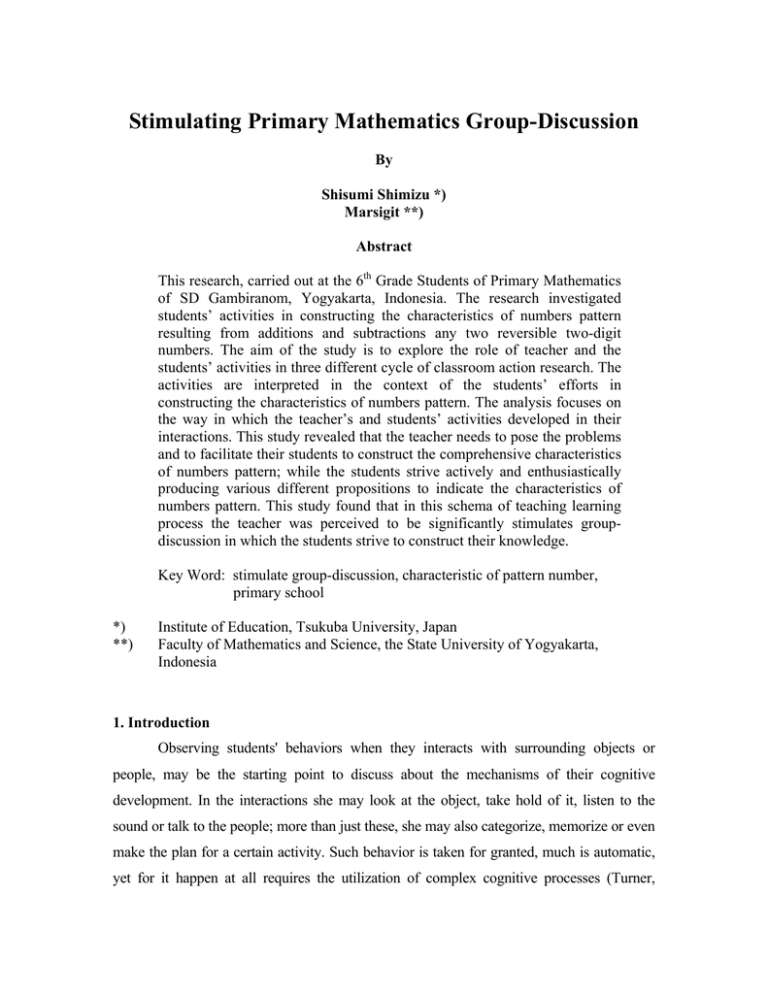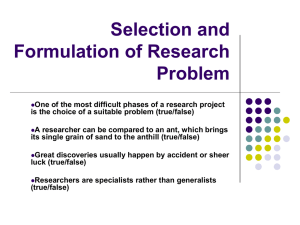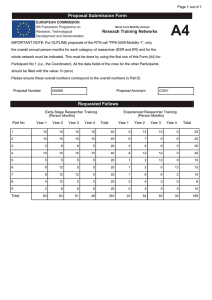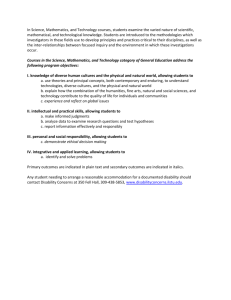Stimulating Primary Mathematics Group-Discussion
advertisement

Stimulating Primary Mathematics Group-Discussion By Shisumi Shimizu *) Marsigit **) Abstract This research, carried out at the 6th Grade Students of Primary Mathematics of SD Gambiranom, Yogyakarta, Indonesia. The research investigated students’ activities in constructing the characteristics of numbers pattern resulting from additions and subtractions any two reversible two-digit numbers. The aim of the study is to explore the role of teacher and the students’ activities in three different cycle of classroom action research. The activities are interpreted in the context of the students’ efforts in constructing the characteristics of numbers pattern. The analysis focuses on the way in which the teacher’s and students’ activities developed in their interactions. This study revealed that the teacher needs to pose the problems and to facilitate their students to construct the comprehensive characteristics of numbers pattern; while the students strive actively and enthusiastically producing various different propositions to indicate the characteristics of numbers pattern. This study found that in this schema of teaching learning process the teacher was perceived to be significantly stimulates groupdiscussion in which the students strive to construct their knowledge. Key Word: stimulate group-discussion, characteristic of pattern number, primary school *) **) Institute of Education, Tsukuba University, Japan Faculty of Mathematics and Science, the State University of Yogyakarta, Indonesia 1. Introduction Observing students' behaviors when they interacts with surrounding objects or people, may be the starting point to discuss about the mechanisms of their cognitive development. In the interactions she may look at the object, take hold of it, listen to the sound or talk to the people; more than just these, she may also categorize, memorize or even make the plan for a certain activity. Such behavior is taken for granted, much is automatic, yet for it happen at all requires the utilization of complex cognitive processes (Turner, 1984). Children’s interactions with adults in terms of a model of guided participation in which children observe and participate in activities, making demands on adults to support them in activities they wish to engage in. The model is broadly conceived in terms of three processes of choosing and structuring children’s activities, structuring responsibility in joint problem solving and transfer of responsibility for managing activities. Although the context in which tasks are performed has begun to form a significant aspect of analysis, it has been interpreted in a variety of ways, sometimes in very local terms, to refer to the conditions under which a particular task is performed, or a particular utterance is made. Others have taken a wider view and suggested that the performance of most activities offers a variety of potential meanings and interpretations, and that the process of interaction involves a negotiation of shared context. We consider the context of teaching learning processes: school, teachers’ aims and classroom. The group discussion is based on principles of promoting children’s growth and development through play activities which encourage children to explore, experiment, question, and talk. Teacher’s efforts to facilitate their students to find various patterns of numbers can be seen as consistent with extending the students’ experiences and encouraging social interaction between children. The small group discussion may be thought of as constituting a set of culturally organized activities provided by the teacher who tried to encourage children to communicate their concepts to the others. Many small group activities are flexible and do not have a clear end point, predetermined by the teacher. Small group discussions offer an interesting context in which to explore the participation of children interacting among the others in naturally occurring open ended activities. In general, when a task has a clear end point, it has been assumed that the children were working towards that point. In this research we are particularly interested in the approach and the schemas developed by the teacher in such a way that the teacher and their students interacted towards the completion of the purposes outlined by the teacher. The main purpose of the research is to actively improve practice of mathematics teaching on the basis of ideal position of good model of primary mathematics teaching and on the basis of assumption that the teacher can learn and create knowledge through his/her concrete experience and observing and reflecting on that experience. The striking benefit of the research therefore is that understanding of the teacher and the situation of teaching learning processes is to be improved. Teacher is perceived to be co-worker in doing research and the researcher is not considered to an outside expert. Thus, the approach of the research is an evaluative-reflective-participatory-critical collaborative enquiry of teaching. Although there are multiple perspectives from which research on teaching can be approached and multiple interpretations of teaching act, one underlying theme needs to be more adequately addressed (Koehler and Grouws in Grouws, 1984). This study bounds territory in which events or processes occured over a specified period. The framework of research is teaching action in mathematics teaching of Primary School Grade VI. 2. Method In this research we have developed three cycles of classroom action research (CAR) of different teaching schemas which forms part of common practice in an educational setting. They aimed to extend children’s learning from cycle 1 and cycle 2 provide the students’ experience to develop their concepts. The process of action research includes problem analysis and a strategic plan, implementation of a strategic plan, observation and evaluation of the action by appropriate methods and techniques, reflection on the results of the evaluation and on the whole action and research process (Zuber and Skerritt, 1992). The researcher needs to fill in the specific conditional features for each level that pertain to the chosen area of action. At every cycle of teaching, the researcher drew up a topic of the session, documenting the shifting focus of the interactions. This was later elaborated in the light of more detailed hand-writing of the interactions. It became evident that building the form of the part of the interactions, which also included extended conversations and interactions between the teacher and theirs students and among the students themselves. The research covers the following action (Zuber and Skerrit, 1992) : (1) identifying and analyzing problems arising in mathematics teaching learning processes, (2) designing the strategies for solving the problems as a results of symmetrical communication among the researchers and the teacher, (3) implementing and testing the strategies, (4) evaluating the effectiveness of the strategies, (5) reflecting the results, (6) arriving at conclusion and/or newly identified problems, (7) repeating the cycle until they were with the improved practice, (8) reporting the findings. 3. Finding and Analysis 3.1. Pre-activity interviews of the teacher The researcher has for along time a good relationship with the teaching staffs of the schools. To prepare this research, the researcher wrote up an account of the interview of the teacher and head teacher. The teacher expressed she intentions for the activity in very general terms. They aimed to encourage the children’s mathematical activities, mathematical skills and social interaction skills. She did not develop specific schema of teaching prior to the classroom action research, as the teaching was perceived to be her routine activities. She went on to describe her practice of teaching as direct teaching; in which she mostly directed her teaching, deliver her information and initiated the activities. Having had interviewed and discussion with the researcher for some time, the teacher understand the aspects of classroom action research and express her willingness to step in and encourage their students to learn mathematics actively. The teacher and the researcher then agree to propose and prepare the series of activities in the schema of classroom action research (CAR). 3.2. Cycle One In the first cycle, the teacher aimed the students to have some competencies to characterize some pattern of numbers producing by doing addition from any two reversible two-digit numbers, as follow: 21 + 21 = … 14 + 41 = … 36 + 63 = … 57 + 75 = … 17 + 71 = … Etc… The schema of teaching learning process in the 1st cycle was characterized as follows. Firstly, the teacher introduced the lesson, delivered information, posed the problems and explained what the students should do in the following activities. Secondly, having had ordering the students to produce additions from any two reversible two-digit numbers, the teacher let the students to work in group-discussion; totally there were 8 group-discussions, each consist of 4 students. Thirdly, the teacher encouraged the students to present their results of discussions and then strive to conclude the results. In this cycle the teacher developed worksheets and distributed them before the students work in their group-discussions. The first step in the analysis was to provide a broad description of the sequence of events during the 1st cycle. In the 1st cycle it was recorded that there was considerable variation in terms of student’s activities. The recorded detail brief descriptions of the sessions were used to refer to analyze and to get feedback for preparing the 2nd cycle. In this session we found that there are some characteristics of students’ efforts to construct their knowledge. Some students indicated that they activities were routine execution of tasks; however, ideas are developed and they try to construct the concepts. Interaction in 1st cycle was characterized as an obvious discussion to share understanding among the children. The students’ activity reflects their deep engagement and interest in the problem solving task There was no indication that the students has a conflict mode to reflects disagreement, however the dominantly role of a certain student begun to be an evident. It was indicated that with the developed schema of teaching learning processes the teacher did not explicitly force their students to pursue the aims of teaching. On the other hand, she encouraged students’ activities towards the achievement of goals by taking the benefits from asymmetrical relationship between teacher and their students and among the students themselves in group-discussion. Some aspects of students’ constructions of their knowledge were invisible and some of them were invisible. In this session, collaborations in group-discussion reflected balancing in students’ social status and power. The constructive interaction among the students reflects various different understandings in a rational way by giving judgments and justifications. This led them to share their understanding of the concepts; it was indicated by their showing for helping and explaining for the purpose of assisting the other to understand the problems. In this session, there were indications that different group-discussion require different situational teacher intervention. The students’ activity reflects their deep engagement and interest in the problem solving task 3.3. Cycle Two In the 2nd cycle, the teacher aimed the students to have some competencies to characterize some pattern of numbers producing by doing subtraction from any two reversible two-digit numbers, as follow : 43 63 81 82 92 - 34 36 18 28 29 = = = = = … … … … … Etc… The schema of teaching learning process in the 2nd cycle was characterized as follows. Firstly, the teacher introduced the lesson, delivered information, posed the problems and explained what the students should do in the following activities. Secondly, having had ordering the students to produce subtractions from any kind of two reversible numbers, the teacher let the students to work in group-discussion; totally there were 8 group-discussions, each consist of 4 students. Thirdly, the teacher encouraged the students to present their results of discussions and then strive to conclude the results. In this cycle the teacher developed worksheets and distributed them before the students work in their group-discussions. The analysis of session in the 2nd cycle examines the ways in which teacher’s approach and process of teaching tasks in their small-group activities. It aims at highlighting students’ activities and situated positions towards knowledge, learning to construct their knowledge. In this session, students are seen as dynamic and contextual in nature, being socially constructed in their interactions small-group discussions. The students’ activity reflects their deep engagement and interest in the problem solving task. There were no indications that the students did not focus on the task. Interaction in 2nd cycle was characterized as an obvious collaborative interaction. The students were not working individually in the group but developed their ideas together. The teacher encouraged students’ activities towards the achievement of goals by taking the benefits from asymmetrical relationship between teacher and their students and among the students themselves in group-discussion. There were several examples of conversations in which some students did not want their talking to be heard by the teacher; on the other word, the teacher needed to give enough time for them to have a discussion in a certain group. There was no indication that the student has a conflict mode to reflect disagreement. In this entire session there was no indication of the students to refuse to engage in certain activity. Some aspects of students’ constructions of their knowledge were visible and some of them were invisible. There was no indication that the students have a conflict mode to reflect disagreement. The teacher encouraged students’ activities towards the achievement of goals by taking the benefits from asymmetrical relationship between teacher and their students and among the students themselves in group-discussion. The results of observations indicated that, among the students, there were various interests of different activities and different way to construct their activities. Some of the children have a separate discussion in the same group-discussion; while others initiated a variety of activities; others kept on the task and the left concentrated to prepare the answer orally the teacher’s question. Most aspects of students’ constructions of their knowledge were visible. 4. Discussion In this study we have been concerned with describing and understanding interactions between teacher and their students and among the students themselves in group-discussions. The theoretical notions from which our analysis started were activity theory, constructive and the concept of guided participation. In particular, the students’ activities and the teacher’s role to encourage them are aspects that were highlighted in this study. Theoretical framework indicated that that the teacher used to emphasize her goal and then directs the students towards it. In group-discussions setting, the unfolding and development of activities is seen both implicitly and explicitly, also there were indications that there were opportunities for students to develop their understanding. When activities did not have a clear endpoint, both the teacher was able to influence the course of the activity, in line with her own interests. The teacher’s role in the activity would be difficult to interpret in the absence of information about the principles group-discussions. The teacher’s perceptions of her role in supporting children’s learning and their intentions for the activity seemed to be changed from one cycle to the next one; and in the entire her activities this also seemed to be evident; one of indication was that the fact that in the initial interviews the teacher described her intentions in general terms and saw the building activity as a vehicle for general cognitive development was not so clear. Teacher’s introductions at any cycle may then be seen as related to the general aims which were adaptable to the development of the individual child. The teacher’s role became one of important factors for their children to develop their cognitive among their constraints in group-discussions. These important roles were not only evident in her having an awareness of the developmental goals, but also the knowledge of their students, her sensitivities to the student’s interests and motivation. There were indications that in each cycle the students were not only simply behave as the performer of the activities but also as the active agent in constructing the activities themselves. Some students were not only remained in their role as the constructor in much of the sessions but also actively adopted other roles while the teacher taking on the role of assistant. The strike effect of activity in group-discussions was that conversational skill of them became the evident; some of them deliver their own initiations, and the other students seemed to take in such a defensive position on their arguments. By observing on the transitions from one activity to another, it became evident that an important aspect of the interaction was concerned with activities of negotiation. Students’ way to achieve the tasks seemed to be different; some did them through quiet persistence and others through explicit way. 5. Conclusion In this classroom action research, the researcher found that if the teacher has good preparation and develop some schemas for her teaching, the students’ role as the constructor of their knowledge became the evident. However, this research indicated that children did not simply perform activities under the guidance of the teacher. They were able to develop their activities based on the influence on the direction and focus of the activities themselves. By observing on the transitions from one activity to another the researcher found that attention to some of worksheets developed by the teacher have influences the course of the activity and have initiated to the various conversations of the interactions. This research also indicated that we can interpret the teacher’s role through students’ perspective on the interaction. This research concluded that through this classroom action research the students were not only become as the active learner but also as lively constructor of their knowledge themselves. References Bliss, et al., 1983, Qualitative Data Analysis for Educational Research, London: Croom Helm. Brannen, J., 1992, Mixing Methods: Qualitative and Quantitative Research, Aldershot: Averbury. Bruner, J. S. (1983) Child’s talk: learning to use language. New York: Norton. Bruner, J. S. (1985). Vygotsky: a historical and conceptual perspective In J. V. Wertsch (Ed.), Culture,communication and cognition: Vygotskian perspectives (pp. 21– 34). Cambridge: Cambridge University Press. Cole, M. (1985). The zone of proximal development. In J. V. Wersch (Ed.), Culture, communication andcognition: Vygotskian perspectives (pp. 146–161). London: Cambridge University Press. Miles, M.B. and Huberman, A.M, 1994, Qualitative Data Analysis: An Expanded Sourcebook, London: Sage Publications. Turner, J.,1984, Cognitive Development and Education, London: Methuen. Vygotsky, L. (1978). Mind in society. Cambridge: Harvard University Press. Vygotsky, L.S, 1966, 'Genesis of the higher mental functions' in Light, P. et al. , 1991, Learning to Think : Child Development in Social Context 2, London : Routledge. Wertsch, J.V., 1985, Vygotsky and The Social Formation of Mind, London : Harvard University Press. Wood, D., 1988, How Children Think & Learn, Oxford: Basil Blackwell. Yin, R.K., 1993, Applications of Case Study Research: Applied Social Research Methods Zuber, O. and Skerritt, 1992, Action Research in Higher Education : Examples and Reflection, London : Kogan Page Limited





